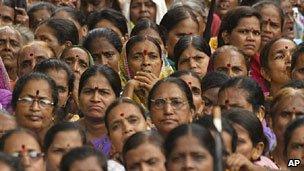Is India's population policy sexist?
- Published
- comments

Female sterilisation is the mainstay of India's population programme
Can the promise of a car or a mixer grinder help keep India's population in check?
Well, that's what health authorities in the northern state of Rajasthan apparently believe. They are offering a cheap car, among other things, as a prize in an attempt to sign up some 20,000 people to meet an ambitious sterilisation target. Time will tell whether this turns out to be another gimmick or an innovative incentive.
But what worries many is the ethics of such sterilisation drives in a largely patriarchal society like India.
As population expert Usha Rai says, the promise of such lucrative incentives typically make husbands push their wives to undergo sterilisation and avoid a range of contraceptives that are available to help limit the size of their families. There's enough evidence to support this concern.
Some 37% of India's married women - who use modern family planning methods - have opted for sterilisation, a government study has found. (Only 1% of males had opted for sterilisation.) Intrauterine devices, condoms and pills were being used by some 10% of the women.
Draconian
In India's most populous state, Uttar Pradesh, with 200 million people - and an economy the size of Qatar which has a population of less than 2 million - the bulk of women who use any modern method of family planning get sterilised.
Ever since the 1970s India has used a combination of coercion and incentives to carry out sterilisation drives to check population growth.
During the 22-month-old Emergency, external in the mid-1970s when prime minister Indira Gandhi suspended democratic rule, the government embarked on a draconian campaign to sterilise poor men - they were dragged into operating theatres in makeshift camps, and police surrounded entire villages at night and herded the men into the camps.

India is home to 17% of the world’s people
More than six million Indian were sterilised in one year - that's 15 times the number of people sterilised by the Nazis. Mrs Gandhi government was routed in the next elections, thanks to the public anger against this drive, among other things. It is "politically dangerous", as one expert says, to target the reproductive ability of men in India.
There is little doubt that unchecked population growth is an existential threat to India - 17% of the world's people live in a country which has only 3% of the world's land area.
'Chilling'
The good news is that India's birth rate has dropped by more than half in 35 years - from 5.7 children per woman in the mid-1960s to 2.7 in 2010. Nearly a third of India's people have lowered their fertility to replacement levels.
The bad news is that India is still set to overtake China as the world's most populous nation by 2030. A Planning Commission report points to a "chilling", external fact: the wide geographical disparity in the projected population growth. The four northern states of Uttar Pradesh, Rajasthan, Bihar and Madhya Pradesh will alone account for 44% of the expected addition of 370 million people to India's population between 2001-26, the report says.
That's not all. Half of India's population is in the reproductive age group. More than 40% of the population increase is contributed by births beyond two children per family. Just over half of the 188 million couples are using contraceptives.
But, as many experts believe, India's family planning programme continues to be sexist. The onus, as award-winning science writer Maria Hvistendahl says, is on women to control their fertility.
Even the Planning Commission admits that female sterilisation has become the mainstay of the programme. High levels of infant and child mortality and preference for sons means that women delay sterilisation.
Experts believe that women should be offered more reversible choices of contraception like injectibles and implants which are not presently offered under India's family planning programme.
More importantly, they say, men should be pushed to take more responsibility for limiting their family - male methods account for only 6% of contraceptive use in India. Should women be bearing the brunt?